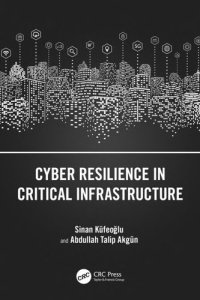
Ebook: Cyber Resilience in Critical Infrastructure
Critical infrastructure sectors are those whose assets, systems, and networks, whether physical or virtual, are deemed so important to nations that their incapacitation or destruction would have a crippling effect on national security, national economic security, national public health or safety, or any combination of these. Each country might define their unique critical infrastructure. In this book, we compiled nine critical infrastructure sectors: Emergency Services, Energy, Finance, Food, Government, Health, Telecommunications, Transport, and Water. The continuity of services in these sectors is vital for the daily lives of societies and economies. This study introduces 49 case studies from various parts of the world.
This book investigates Cyber Resilience in Critical Infrastructure by paying attention to recommending a national-level cyber resilience framework for all nations to use. Furthermore, we present sectoral analysis and case studies for each infrastructure by going through an in-depth analysis. As military tensions grow in many parts of the world, nations are alarmed and focused on their national cyber resilience, especially the reliability of their critical infrastructure. We believe this book will be a popular reference and guidebook for a wide range of readers worldwide, from governments to policymakers, from industry to the finance sector, and many others.
Most cyberattacks occur in the following types: Insider attacks, social engineering, exploitation malware, extortion, and blackmail. The rising interconnectedness of vital infrastructures via IoT technologies, as well as the rise of coordinated cyberattacks worldwide, is a concerning issue. There are different types of attacks. While some of them are simultaneously IoT-based attacks, some of them are not. Therefore, IoT causes extra vulnerability to systems. Since the IoT is the evolution of Machine-to-Machine communication, and it uses embedded electronics to link everyday things to the Internet, with minimum human effort, these linked items can exchange and gather data. Digital systems can record, monitor, and alter each interaction between linked items in today’s hyper-connected environment. Although IoT is a beneficial breakthrough and has become widespread, it is vulnerable to cyberattacks.
If devices connect to the Internet, they are considered within the IoT concept. This way, practically all cyber incidents in IP-based systems may affect IoT devices. For example, a teen hacked Lodz city’s tram system with a homemade transmitter and rerouted trains. This is the first cyber kinetic attack that has resulted in injuries. To provide another example, the attackers infiltrated a water utility’s SCADA system and manipulated the system to change the number of chemicals used. Thus, they intervened in water treatment and production.
This book investigates Cyber Resilience in Critical Infrastructure by paying attention to recommending a national-level cyber resilience framework for all nations to use. Furthermore, we present sectoral analysis and case studies for each infrastructure by going through an in-depth analysis. As military tensions grow in many parts of the world, nations are alarmed and focused on their national cyber resilience, especially the reliability of their critical infrastructure. We believe this book will be a popular reference and guidebook for a wide range of readers worldwide, from governments to policymakers, from industry to the finance sector, and many others.
Most cyberattacks occur in the following types: Insider attacks, social engineering, exploitation malware, extortion, and blackmail. The rising interconnectedness of vital infrastructures via IoT technologies, as well as the rise of coordinated cyberattacks worldwide, is a concerning issue. There are different types of attacks. While some of them are simultaneously IoT-based attacks, some of them are not. Therefore, IoT causes extra vulnerability to systems. Since the IoT is the evolution of Machine-to-Machine communication, and it uses embedded electronics to link everyday things to the Internet, with minimum human effort, these linked items can exchange and gather data. Digital systems can record, monitor, and alter each interaction between linked items in today’s hyper-connected environment. Although IoT is a beneficial breakthrough and has become widespread, it is vulnerable to cyberattacks.
If devices connect to the Internet, they are considered within the IoT concept. This way, practically all cyber incidents in IP-based systems may affect IoT devices. For example, a teen hacked Lodz city’s tram system with a homemade transmitter and rerouted trains. This is the first cyber kinetic attack that has resulted in injuries. To provide another example, the attackers infiltrated a water utility’s SCADA system and manipulated the system to change the number of chemicals used. Thus, they intervened in water treatment and production.
Download the book Cyber Resilience in Critical Infrastructure for free or read online
Continue reading on any device:

Last viewed books
Related books
{related-news}
Comments (0)